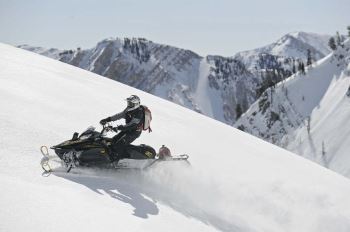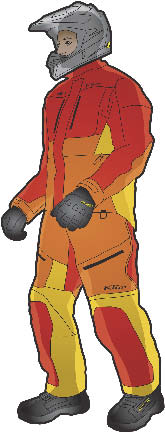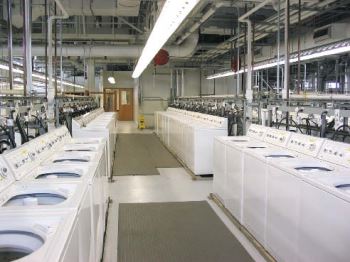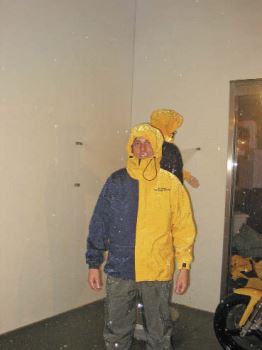 The rows of washing machines are still going 24/7. The rain room is still dumping rain like a hurricane. And the wet flex testing room is still marching on.
The rows of washing machines are still going 24/7. The rain room is still dumping rain like a hurricane. And the wet flex testing room is still marching on.
Many things are still the same at Gore-Tex's sprawling campus in eastern Maryland and western Delaware as what we experienced a few years ago when we first toured some of the different facilities.
But this time around, on our latest tour this past April, we got to see a couple of things we didn't experience during our previous trip to Gore-Tex. And we learned about something new as well-a process of building a new snowmobile jacket using what's being named Comfort Mapping. Klim, based in Rigby, ID, is using Comfort Mapping in its new Valdez Parka and Togwotee Bib, along with the Powerxross Pullover and Free Ride Pant, released this fall in time for the 2008-09 season.
 Basically, Comfort Mapping is new technology that creates a garment that meets the specific needs of each region of the body, instead of a garment that covers your body and treats different parts of your body equally. While we have yet to wear a garment with this new technology built-in, Comfort Mapping seems to go farther than simple pit zips and the like. It's more like making a jacket that takes the breathability, windproofness and waterproofness that Gore-Tex and Klim have become known for to the next level.
Basically, Comfort Mapping is new technology that creates a garment that meets the specific needs of each region of the body, instead of a garment that covers your body and treats different parts of your body equally. While we have yet to wear a garment with this new technology built-in, Comfort Mapping seems to go farther than simple pit zips and the like. It's more like making a jacket that takes the breathability, windproofness and waterproofness that Gore-Tex and Klim have become known for to the next level.
Put another way, Comfort Mapping attacks those problems many of us snowmobilers face who need outerwear that keeps the hot spots of our bodies cool and the cold spots warm. As it was presented to us, "Not everyone knows that the upper body can lose the greatest amount of warmth at the shoulders, especially in snowy or rainy weather. Or that loss of heat in the kidney areas contributes to excessive cooling."
Yellow, Orange, Red
 The concept of Comfort Mapping is best illustrated by the accompanying drawing (see Fig. 1) showing the Valdez Parka and Togwotee Bib. The jacket and bibs are divided into three different thermal zones, noted by the red, orange and yellow colors. The red areas offer high thermal retention while the orange areas have medium thermal retention and yellow low thermal retention. Look at the chest and shoulder area, for example. With today's mountain sleds, which offer low to no windshields, the wind and cold (and snow) hit right in the chest. Hence the need for high thermal retention in that area. Under the arms, however, where there seems to never be a lack of heat (read: sweat), there's low thermal retention. The same goes with the bibs. The shins to the knees usually are cold areas due to the wind and cold hitting the front of the legs.
The concept of Comfort Mapping is best illustrated by the accompanying drawing (see Fig. 1) showing the Valdez Parka and Togwotee Bib. The jacket and bibs are divided into three different thermal zones, noted by the red, orange and yellow colors. The red areas offer high thermal retention while the orange areas have medium thermal retention and yellow low thermal retention. Look at the chest and shoulder area, for example. With today's mountain sleds, which offer low to no windshields, the wind and cold (and snow) hit right in the chest. Hence the need for high thermal retention in that area. Under the arms, however, where there seems to never be a lack of heat (read: sweat), there's low thermal retention. The same goes with the bibs. The shins to the knees usually are cold areas due to the wind and cold hitting the front of the legs.
That also goes to show, in our minds, someone (namely Klim and Gore-Tex) is  paying attention to how western snowmobilers ride, which is standing up quite a bit of the time. Those areas, the chest and front of the legs, are exposed more than what might be on a trail rider. Yes, that's a real general statement, but it is true and that's why western riders have different needs. It took the industry a while to recognize the need for a true mountain machine and we got one. And now we have the clothes to go with those sleds.
paying attention to how western snowmobilers ride, which is standing up quite a bit of the time. Those areas, the chest and front of the legs, are exposed more than what might be on a trail rider. Yes, that's a real general statement, but it is true and that's why western riders have different needs. It took the industry a while to recognize the need for a true mountain machine and we got one. And now we have the clothes to go with those sleds.
The Comfort Mapping technology has been in testing for the past two years by the guides at Togwotee Mountain Lodge. That's a pretty good group to be testing how this kind of clothing might work. The result of that testing is what the rest of us sledders will see this fall when Klim releases its new line of clothing.
 We've been impressed with Gore-Tex and Klim's claims of waterproofness, breathability and windproofness, as well as the functionality of the clothing (it just fits right). Now we're anxious to see how this Comfort Mapping really works.
We've been impressed with Gore-Tex and Klim's claims of waterproofness, breathability and windproofness, as well as the functionality of the clothing (it just fits right). Now we're anxious to see how this Comfort Mapping really works.
To achieve the right protection in the various spots in the Comfort Mapping system, varying degrees and types of insulating materials have been integrated into strategic areas of the clothing. Thus, as the officials at Klim state, "This helps effectively manage the body's thermal requirements by allowing better breathability in those areas that need to breathe and better thermal protection in those areas that need to be protected."
Three-Layer Construction
 What really makes Comfort Mapping work is what Klim calls "Three-Layer Construction." It's explained this way. A three-layer fabric is made up of three different pieces of material each having a specific function. These three layers are permanently laminated together to form one integrated piece. The outer fabric (or face fabric) is usually a durable piece of nylon that protects the riding gear. The middle layer is a Gore-Tex membrane that is durably waterproof and breathable. Finally, there is the inner layer (or backer). With Comfort Mapping, a thicker inner layer is used in areas where the body needs more insulation. Likewise, a thinner material is used in areas that tend to build up excess heat.
What really makes Comfort Mapping work is what Klim calls "Three-Layer Construction." It's explained this way. A three-layer fabric is made up of three different pieces of material each having a specific function. These three layers are permanently laminated together to form one integrated piece. The outer fabric (or face fabric) is usually a durable piece of nylon that protects the riding gear. The middle layer is a Gore-Tex membrane that is durably waterproof and breathable. Finally, there is the inner layer (or backer). With Comfort Mapping, a thicker inner layer is used in areas where the body needs more insulation. Likewise, a thinner material is used in areas that tend to build up excess heat.
Granted, Comfort Mapping and polytetrafluoroethylene (the material Gore-Tex membranes are made of) are more technical than most sledders want to get with their clothing. We just want the jacket and bibs and gloves and boots to work.
If Gore-Tex and Klim's track record are any indication of what's to come with Comfort Mapping, then it's a pretty safe bet that western riders will be happy once again this season.
Polytetrafluoroethylene
Or PTFE for short. This product is the core of Gore-Tex and what the company was founded on. Gore-Tex has made its living by processing PTFE into a myriad of remarkable products, including the membrane that is used in Klim's and other companies' outdoor clothing.
Polytetrafluoroethylene was discovered in 1938 and is a white solid polymer containing carbon and fluorine linear chains. It is derived from a fluorine-containing mineral, fluorspar, and chloroform. People a lot smarter than we are, most notably company founder Bill Gore, figured out that a series of complex reactions result in a dispersion of tiny PTFE particles in water. The PTFE is precipitated and then dried into a fine white powder that is then made into the Gore-Tex membrane.
The membrane contains more than nine billion microscopic pores per square inch. These pores are 20,000 times smaller than a water droplet, but 700 times larger than a water vapor molecule. This makes the membrane completely waterproof from the outside, but still able to allow perspiration to escape from the inside. That's where the waterproofness of Gore-Tex comes from.
PTFE's, and the subsequent expanded PTFE (ePTFE), unique properties, such as low chemical (meaning the membrane is not harmed by motor fuels or oils) absorption, UV resistance, broad thermal range, low wear resistance and expandability, to name just a few, are what make the resulting membrane so useful in snowmobile and other winter clothing.
Breathability is another major feature of the Gore-Tex membrane. As Gore-Tex points out, "It's a common misconception that breathability involves air passing through fabric. The measure of air movement through the fabric is called windproofness." However, breathability is "moisture vapor permeability" or the fabric's ability to allow perspiration vapor to pass through the fabric. Remember the numbers quoted above? The pores are small enough to prevent water droplets from entering but big enough to let water vapor (a nice way of saying sweat) escape. If the sweat doesn't get out, we get pretty uncomfortable, especially when it cools off and makes us cold.
Others use a coating (or laminate) to achieve the waterproofness, whereas, the Gore-Tex way is the membrane.